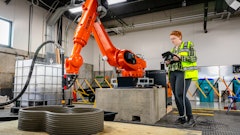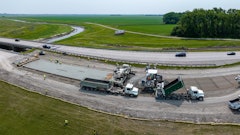
The construction sector has a severe staffing issue.
According to the Associated Builders and Contractors (ABC), the construction industry will need to attract 546,000 new workers to keep pace with the demand for labor. This is much more than just a potential problem for tomorrow. It’s an urgent concern right now. Nearly one-quarter of construction workers are older than 55, making an imminent retirement wave a threat to several priorities, including expanding access to affordable housing and community development.
Finding qualified professionals to take their places won’t be easy. Even with 2.1 million people expected to leave other industries to work in the construction sector–more than offsetting the 1.9 million who will leave the construction sector in 2024; just to keep up with demand, ABC estimates that the U.S. construction sector will need to attract 500,000 new workers this year.
What’s more, with construction jobs increasingly requiring advanced technological skills, companies will need to upskill and retool a significant portion of their existing workforce to keep pace with changing building strategies and best practices.
In other words, the construction sector’s talent shortage is more than just a hiring issue. It’s a holistic rethinking of their workforce, requiring more and more skilled employees to meet demand.
While no single solution will address this challenge completely, technology advancements can play a critical role in empowering and rejuvenating the construction sector workforce. Simply put, technology addresses immediate workforce gaps and plays a crucial role in long-term industry productivity improvements. Here’s how the industry can use it even more fully to its advantage this year and beyond.
A Younger, Tech-Centric Talent Pool
Today’s students and college graduates are technology-natives. They’ve never known a world that wasn’t dominated by ubiquitous internet access, highly capable and accessible hardware, and app-driven experiences. Increasingly, this means that GenZ employees and prospects aren’t just tech-natives. They are AI natives as well.
According to Axios, “College students are piling into generative AI (GAI) courses — the better to give them an advantage in the growing number of jobs requiring such skills.” The construction sector can’t afford to be left behind, requiring it to combat the perception that construction is exclusively a manual-labor-saturated field without access to or the need for high-tech solutions. In fact, the industry is actively implementing digital technologies at every project stage, from ideation and planning to real-world implications and tactical execution.
To engage a younger, tech-centric talent pool, the construction sector and local companies should consider developing internship programs and other partnerships with universities that offer courses related to the construction industry, such as construction management, real estate development, architecture, and engineering.
Collaborating with universities and community-based educational initiatives allows construction entities to take advantage of the school's efforts to attract students and promote internships and career opportunities in the construction industry. This approach helps companies engage students who are already interested in related fields and might be looking for real-world applications for their studies.
When interacting with students, whether through internships or speaking engagements at universities, showcase the use of modern technology in projects and operations. By demonstrating the use of advanced tech stacks and digital solutions, rather than outdated software or manual processes, construction companies are actively engaging their future talent, proving that it is appealing and compelling to the next generation of construction professionals.
Leverage Tech to Operate More Efficiently
Integrating the latest technologies into modern construction workflows, including administrative automation, streamlined workflows, enhanced communication protocols, and data-driven decision-making, elevates efficiency and effectiveness.
This process should not be daunting for construction companies. After all, legacy technology hinders innovation and improvement, increases costs, and limits opportunities for growth and expansion. For instance, legacy systems can limit a company's ability to adopt additional, niche technological solutions due to budget constraints and operational inefficiencies. In contrast, modern technology stacks offer a more cost-effective and efficient solution, enabling construction companies to leverage a wider array of tools and applications that enhance project management, safety, and other critical aspects of construction work.
Once a modern tech stack is adopted, there are immediate efficiency and automation opportunities. This includes automated project reminders, the streamlined creation of workflows that connect all stakeholders, and enhanced document management, creating substantial time savings by consolidating information from numerous stakeholders into a single, accessible location.
It also creates a proper data index that, especially when paired with burgeoning capabilities from AI and ML technologies, creates searchable, analytical data sets that unlock even more potential as specific details within project plans, drawings, or documents become accessible. Unlike the traditional methods of sifting through PDFs, emails, Excel files, or even physical notes and drawings, modern systems enable quick keyword searches, saving measurable time and effort.
Streamline the Knowledge Gap and Process Training
The use of technology allows for better collaboration and communication, creating a "text-like" environment for specific operational functions of the project. This is particularly useful for managing Requests for Information (RFIs) or submittals, where traditional email chains can become cumbersome and inefficient. With software solutions that can centralize thousands of pieces of information, including attachments and markups, facilitating the transfer of information across dozens of different stakeholders has never been easier.
As a result, tech-enabled teams can maintain their flow of communication and ensure that all team members have access to the latest data and project updates. In this way, construction tech solves for proper workflow visualization. It enables seamless communication, akin to a group chat environment, but specifically tailored for construction project management tasks such as scheduling, RFIs, and submittals.
Ultimately, when teams work better together, they maximize available resources, ensuring every team member can accomplish as much as possible. It doesn’t eliminate the consequences of a staffing shortage but allows every construction team to make the most out of their personnel in every circumstance.
The construction industry faces a significant staffing challenge, exacerbated by an aging workforce and the increasing demand for technologically skilled employees. However, technology presents a viable solution to bridge this gap and revitalize the sector. By engaging a younger, tech-centric talent pool and leveraging technology to enhance operational efficiency and effectiveness, the construction industry can bridge the staffing gap and thrive for years to come.



























